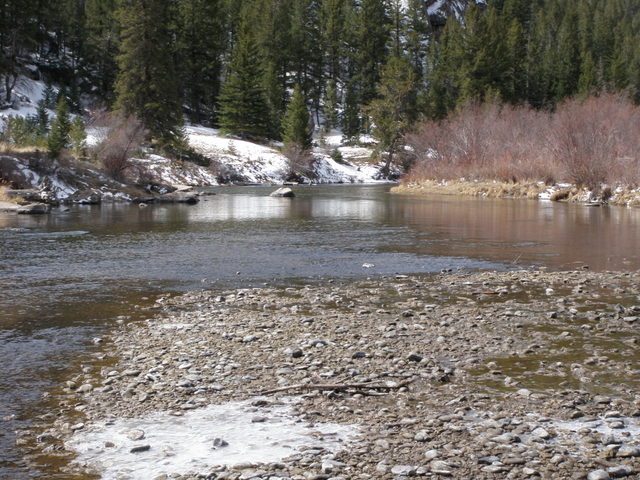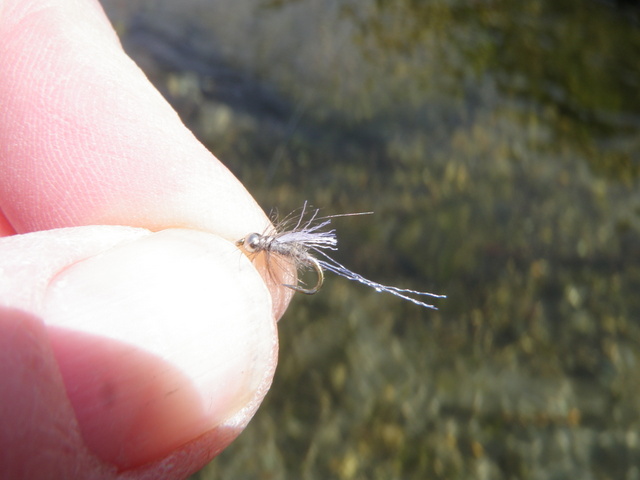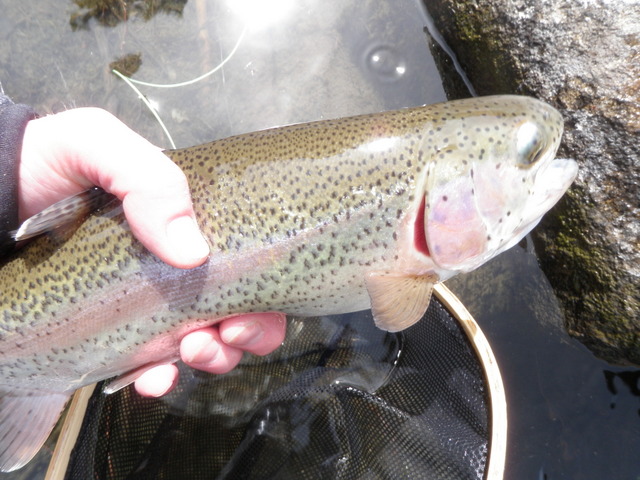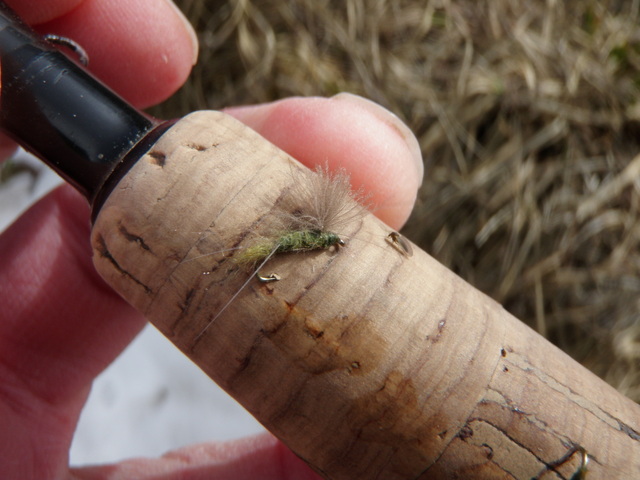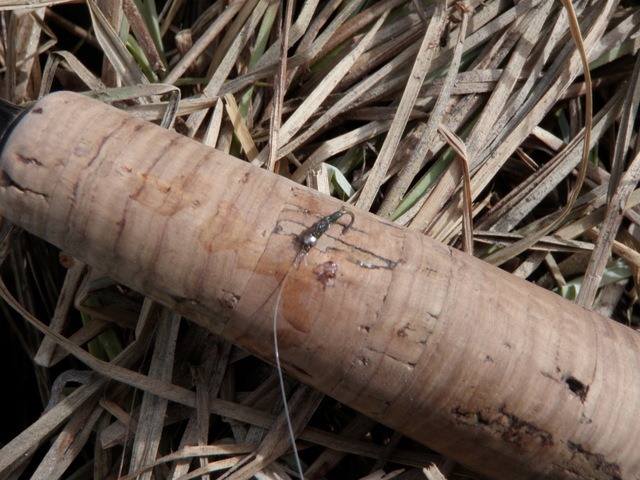Time: 11:00AM – 4:30PM
Location: Upper mile below dam and then downstream on north side of twin tunnels
Fish Landed: 3
South Platte River 04/15/2014 Photo Album
Three hours of blue wing olives hatching and abundant quantities of large trout would seem to portend a great day of fishing, and it was, but not without some hardship. At the beginning of the week I studied the weather forecast as I was hoping to fish on Thursday and ski on Friday. Monday was cold with leftover snow accumulations from Sunday night. Tuesday called for highs in Denver in the low 60’s. Wednesday was not an option due to commitments at work, and Thursday projected as another cold front with high temperatures spiking in the 40’s. Friday was the nicest day, but I’d already committed to spring skiing at Vail with friends.
I decided that Tuesday would be the day, but now I needed to determine a destination. I eliminated the Arkansas River quickly as it represented a long drive, and my results the previous week were disappointing. The Big Thompson was only flowing at 26 cfs so that sounded challenging, and a report on the St. Vrain River below Buttonrock stated that one of my favorite destinations would not be open until 2015 due to September flood damage. Flows on the South Platte River in Waterton Canyon were over 300 as well as the South Platte below Cheesman Dam. These are reasonable levels, but they increased from the low one hundreds in the last two days, and I haven’t had good results when water levels change dramatically.
The South Platte River below Eleven Mile Reservoir, however, was running in the high 80’s, and the high temperature was projected to be in the low 50’s, so this became my choice. I took my time getting ready as I knew it would take some time for the air temperature to get to tolerable levels in the mid-40’s. At 7:45 I was set with the car loaded with all the necessary items for a day on the river. I encountered heavy traffic on interstate 225 near the junction with I25, but again I wasn’t trying to arrive early, so I relaxed and listened to music from my iPod.
When I arrived at the entrance to Eleven Mile Canyon and paid my day use fee, the temperature was 39 degrees, so I drove very carefully and slowly to the dam to check out the water. The water appeared to be delightful, but shaded areas displayed a couple inches of snow and the wind was shaking the trees and willows along the stream. I didn’t encounter other fishermen until the last mile or two below the dam, and here I discovered quite a few, so I executed a U-turn in the parking lot and reversed my direction. I found a nice large gap between parked cars approximately a mile below the dam and pulled over and prepared to fish. I killed some more time by eating a granola bar and slowly applied sunscreen to my face and hands. I couldn’t delay any longer so I opened the door and absorbed a cold blast of wind.
I didn’t spare any layers and pulled on my Adidas pullover, a heavy fleece cardigan, and my down vest and then pulled my waders over the top while wondering how the Michelin man manages any mobility. To top things off I donned my New Zealand brimmed hat with ear flaps and after stringing my Loomis 5 weight, I was on my way. I followed a worn path thirty yards downstream and cut over to the river. I didn’t notice any surface activity, so I waded downstream a bit further to the tailout of a long riffle and tied on a Chernobyl ant with a beadhead RS2 dropper and began working the soft water along the left bank. Already I was noticing the difficulty of casting into a stiff headwind, but it was early in the day, and I didn’t give it too much thought.
After covering some marginal water without any action or seeing any fish scattering from bank lies, I came upon a nice deeper pool and riffle behind some exposed rocks serving as a nice current break. I paused and observed the water and immediately I spotted two then three then at least five to ten nice fish holding in the pool and run. Unfortunately these fish were totally ignoring my Chernobyl and RS2, so I clipped off the nymph and replaced it with an apricot egg and then added a third fly, a size 20 soft hackle emerger.
It was downright cold, and the wind continued to be a nuisance, but the sight of nice fish finning in the pool ahead of me allowed me to ignore the weather difficulties. As I prospected my three fly menu, I began to observe swarms of tiny midges buzzing along the surface of the river. The fish were also becoming more active, and my polarized lenses allowed me to see them moving subtly from side to side. This behavior usually indicates feeding on subsurface nymphs and larva in the drift, but they were having none of my soft hackle emerger.
As all this observation was going on, I now began to notice larger insects tumbling across the surface, and upon closer examination and during a lull in the wind, I spotted a blue wing olive mayfly riding by me on the surface current. This was followed with a few sporadic rises from two of the fish in front of me. I couldn’t understand why my soft hackle emerger wasn’t attracting interest since historically it worked in these same circumstances on other rivers. But the fish were active, and my flies weren’t effective, so I concluded a change was in order.
Off came the Chernobyl, the egg, and the soft hackle emerger; and they were replaced with a size 22 CDC BWO dry fly. I began overpowering forward casts in order to punch the tiny fly into the headwind, and as I did this, the frequency of trout breaking the surface picked up a bit. Unfortunately none of the trout were in a regular rhythmic feeding pattern, so it was difficult to choose which fish to focus on. I spotted a fish to my right and fifteen feet upstream that rose a couple times, so it became my target. This fish was moving around quite a bit subsurface, but occasionally it rose to the surface and gulped a mayfly from the surface film.
I cast repeatedly and shifted my target off and on, but eventually I returned to the fish described above and after perhaps half an hour and 50 casts, the fish tipped up and sucked in my imitation. I executed a solid hook set and played a strong rainbow trout, and after a few strong but futile runs, I was able to slide my net beneath the 15 inch pink sided warrior. I shuffled over to the bank and managed to grip the fish long enough just above the net to snap a photo. I’m being extremely conscious of not removing fish from the water more than a few seconds as I go forward. I approximated the rainbow’s length at 15 inches, and it exhibited a healthy girth for that length of fish.
Fish continued to rise in this area after I rested it a bit, but I was anxious to move on, so I waded up along the right bank a bit. In previous circumstances such as this, I’ve had success getting above fish and drifting my dry fly downstream to their position, so I tried this for a bit, but on this windy day in April the technique was having no impact.
The next water above the current break was a wide riffle approximately three to four feet deep with a stronger main current running along the left bank. As I approached the water I could see at least seven or eight fish in the riffle. They appeared as dark fish shapes against the light sand bottom of the river. Careful observation also revealed that these fish were rising sporadically to the surface, but they were also moving about and taking something subsurface. I resumed my furious casting into the wind and began covering the locations where I spotted fish. This went on for another hour or so, and I did manage two or three momentary hook ups with my tiny fly. It seemed that I should be getting more attention from my fly given the increased amount of surface feeding from this pod of fish.
My theory is that the trout were accustomed to seeing the adult BWO’s tumbling across the surface due to the strong wind, and my artificial floated along without any sort of skittering or movement. Finally after an enormous amount of exaggerated casting into the wind and some frustrating momentary hook ups, I noticed a fish tip up near my fly, so I set the hook and felt the weight of another nice fish. When I eventually landed this beauty, my net revealed a silvery pink striped rainbow that was nearly the same size as my first fish. I carefully snapped another head shot and released this gem back into the river.
I was now verging on shivering uncontrollably, but as long as the hatch was continuing I was hesitant to return to the car to warm up and eat lunch, but there was no more deferring of this necessary reprieve in my fishing day. I returned to the car and quickly ate my minimal lunch and warmed my body and feet. Sheltered from the wind inside my SUV, I was amazed at how comfortable the day was.
Another car arrived while I was preparing to resume fishing, and it parked along the road forty yards further upstream, but I decided to return to my exit point and resume assuming I still had some space to work before conflicting with the new arrivals. When I arrived back at the river, I quickly passed some unattractive water until I approached some nice deep runs and riffles approximately twenty yards below the pullout with the forest green car that arrived as I was preparing to fish. Once again I could spot some nice fish in this area, but not nearly the concentration that I’d witnessed further downstream. The hatch had now waned to very sporadic tumbling mayflies, and there may have been one or two visible rises while I was watching.
I made some good casts and presentations to the areas where I observed rises, and I experienced one more momentary connection, but I was now bumping into the territory of the next group of fishermen, so I climbed up the bank and returned to the car. I broke for lunch at 1:30 and after this brief resumption of fishing, it was probably 2PM when I unlocked the car and threw my gear in the back. I decided to drive further downstream to the bottom of the special regulation area and fish there for the remainder of the afternoon.
I found a nice wide pullout a half mile or so beyond the twin tunnels and this was above a wide smooth pool where the river could spread out briefly after going through a more narrow canyon stretch. I descended to the top of the pool, and I was weary of casting tiny dry flies into the wind over very selective fish, so I decided to try the strike indicator nymphing technique. Also I was not seeing any mayflies on the surface anymore, but I did see quite a few extremely small cream colored midges swarming about. I elected to go to an indicator and split shot and beneath that I tied an orange scud and then a small size 22 RS2.
I worked some nice deep pockets along the left bank and did spot an occasional fish that ignored my offerings, but then I approached a nice long narrow deep pool. Before I cast, I could see five or six decent fish lined up across the river in some slower moving water at the top of the pool. I didn’t hold out much hope that my nymphs would fool these fish since the surface was rather smooth and my cast would surely create a noticeable surface disturbance. I made five or six half hearted casts above the visible fish, and tried to impart some movement and swing to my flies. Miraculously on the seventh or eighth drift I was shocked to see one of the lined up fish closer to the far side dash two or three feet to the side to snatch something, and it was approximately where my trailing fly was, so I set the hook and found myself attached to the fish.
What a thrill as I battled another rainbow and brought it to my net, and this fish measured around 13 inches. I’d already conceded to a two fish day, so this late surprise was a bonus. I was reinvigorated by this catch and continued working my way upstream with the nymph offerings, but unfortunately my new enthusiasm was not rewarded. By 4:30 I was once again chilled and the relentless wind forced me to climb the steep rocky bank to the road and return to the Santa Fe.
In spite of the low fish count of three, it was a very enjoyable outing. Being able to see large actively feeding fish always gets my juices flowing, and that’s what held my interest for most of Tuesday on the South Platte. I will certainly look for additional opportunities to visit Eleven Mile Canyon in the spring of 2014 before the water management folks open the gates and release large volumes of water from the dam.

